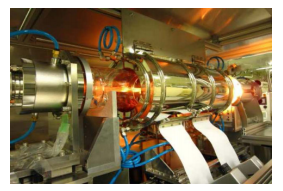Despite extensive studies, AlN-based device performance is currently limited; for example, the external quantum efficiency (EQE) of AlGaN light-emitting diodes (LEDs) is at most ~15% in the spectral range of 260–300nm and decreases at shorter wavelengths. (It is noteworthy that EQE of InGaN blue LEDs has exceeded 80%17). Because AlN substrates are immature and quite expensive, foreign substrates such as sapphire and silicon carbide (SiC) are widely used in devices1–7,10,11,14,15. Unfortunately, the lattice and crystallographic mismatches between AlN and a foreign substrate induce threading dislocations, which are on the order of 109 –1011 /cm2 in the epilayer. One effective way to improve device performance is to further develop AlN bulk single crystals as the substrate, which may significantly reduce the number of threading dislocations in the device.
Because the reaction of Al+ 1/2N2 → AlN is seemingly inactive, especially due to the inert nature of N2 gas, AlN crystal growth usually involves processes to activate Al and N. For example, HVPE uses NH3 and Al-trichloride generated via a reaction between Al and HCl, while sublimation requires AlN powders and extremely high growth temperatures around 2000 °C. [This is also true for other thin film growth techniques. Typically, molecular beam epitaxy (MBE) adopts a plasma to excite N2 28, whereas metalorganic vapor phase epitaxy (MOVPE) uses Al-metalorganic and NH3 29,30]. That is, although AlN itself is an ecological material, the present growth processes are environmentally burdensome (e.g., employing toxic gases and high temperatures).
In addition to growth methods, how to nucleate AlN is another critical issue. Similar to thin film growth, homoepitaxial and heteroepitaxial nucleations are possible for bulk AlN single crystals. For HVPE, homoepitaxy on AlN substrates grown by sublimation8,20 and heteroepitaxy on sapphire or SiC substrates18,19,21 have been investigated. For sublimation, spontaneous nucleation of AlN and subsequent homoepitaxy22–24, and heteroepitaxial nucleation on SiC25–27 have been demonstrated. Homoepitaxial nucleation realizes a much higher crystalline quality with a dislocation density of 103 –105 /cm2 , but enlarging AlN crystals to a size suitable for industrial applications remains a challenge. On the other hand, heteroepitaxial nucleation may involve more dislocations, but can realize a larger AlN diameter because more than three-inch sapphire and SiC are commercially available.
Because nitridation affects the color and grain size, the crystallographic states were investigated with x-ray diffraction (XRD) measurements. Figure 2c shows the simulated profile of the AlN polycrystalline powder (upper) and the experimentally obtained profile after nitridation (lower). The simulation assumed a hexagonal wurtzite structure, which is the most stable structure for AlN. The good agreement between the simulation and experiment indicates that AlN polycrystals are successfully synthesized via direct nitridation.

Fig1
In addition to growth methods, how to nucleate AlN is another critical issue. Similar to thin film growth, homoepitaxial and heteroepitaxial nucleations are possible for bulk AlN single crystals. For HVPE, homoepitaxy on AlN substrates grown by sublimation8,20 and heteroepitaxy on sapphire or SiC substrates18,19,21 have been investigated. For sublimation, spontaneous nucleation of AlN and subsequent homoepitaxy22–24, and heteroepitaxial nucleation on SiC25–27 have been demonstrated. Homoepitaxial nucleation realizes a much higher crystalline quality with a dislocation density of 103 –105 /cm2 , but enlarging AlN crystals to a size suitable for industrial applications remains a challenge. On the other hand, heteroepitaxial nucleation may involve more dislocations, but can realize a larger AlN diameter because more than three-inch sapphire and SiC are commercially available.
Herein we propose a novel route to realize environmentally friendly growth of AlN using only elementary Al and N2 gas as the source precursors. Initially, thermodynamic analysis is used to examine the reactivity between Al and N2 to create AlN. Then a growth apparatus is constructed to realize the reaction Al+ 1/2N2 → AlN. Using the developed apparatus, AlN single crystals are successfully grown at a rate of ~18 μm/h at 1550 °C. The growth rate is comparable to that by HVPE, and furthermore, the growth temperature is much lower than that in sublimation (~2000 °C). We employed heteroepitaxy on sapphire substrates as a nucleation method because this study demonstrates proof-of-concept AlN growth and heteroepitaxy is easier and more cost effective than homoepitaxy for this purpose.
上一篇: 氮化铝宽带隙半导体及其特性